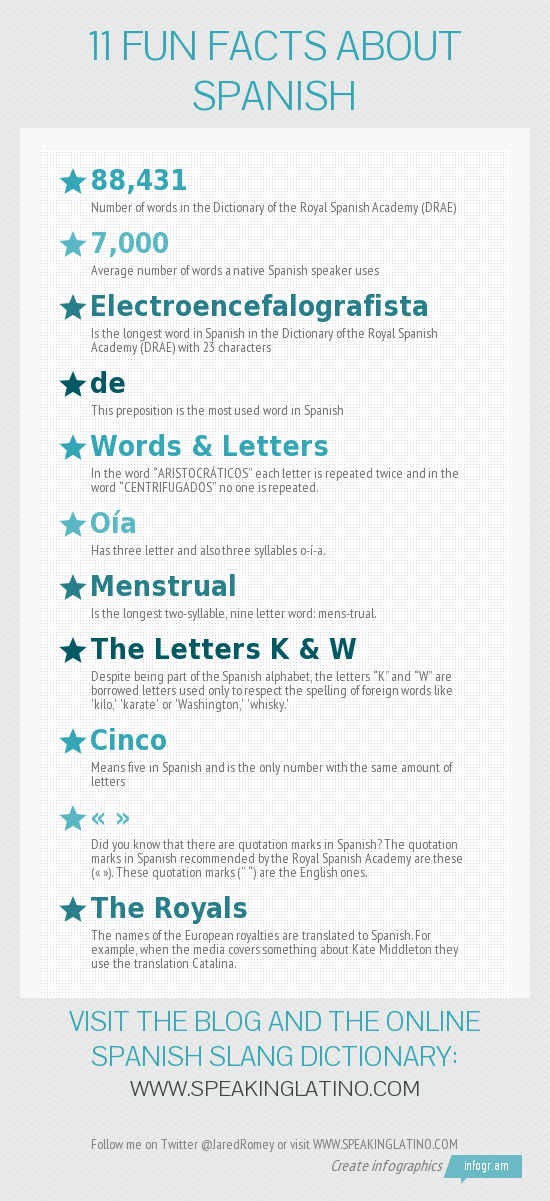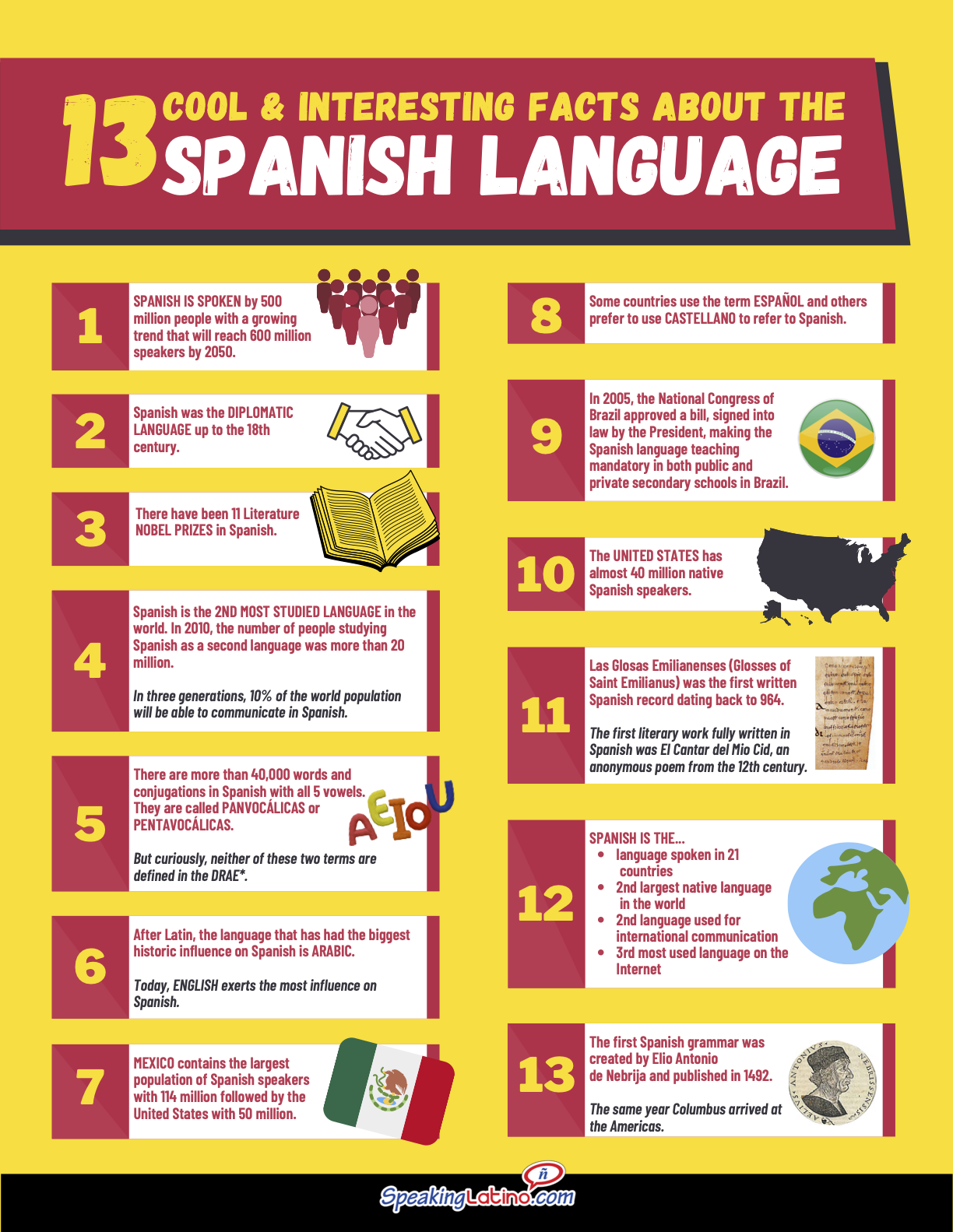There is a big party going on! A celebration of 500 million people and 22 countries that speak Spanish!
April 23rd is the International Spanish Language Day or Día Mundial del Idioma Español, a celebration that has been going on since 1926. This date marks the death of Miguel de Cervantes Saavedra, author of El ingenioso hidalgo don Quijote de la Mancha, the masterpiece of Spanish literature. To celebrate this big day, here are some facts about Spanish.
While these language curiosities might be useless if what you are looking for is to learn Spanish, they are definitely fun to know.
11 Facts About Spanish: Infographic

For more Spanish language curiosities read the article 13 Cool and Interesting Facts About the Spanish Language or check out the book Compendio ilustrado y azaroso de todo lo que siempre quiso saber sobre la lengua castellana.
Congratulations Spanish!
11 Useless Fun Facts About Spanish (Text transcript and sources)
- At the moment of creating the infographic, the Dictionary of the Royal Spanish Academy (DRAE) had 88,431 words. –Source: DRAE 22nd edition
- The average native Spanish speaker uses about 7,000 words. -Source: ABC.es
- “Electroencefalografista” has 23 characters and is the longest word in Spanish in the Dictionary of the Royal Spanish Academy (DRAE). -Source: ABC.es
- The most used word in Spanish is the preposition “de.” -Source: Listado de frecuencias del CREA
- In the word “aristocráticos” each letter is repeated twice and in the word “centrifugados” not one is repeated. -Source: Compendio ilustrado y azaroso de todo lo que siempre quiso saber sobre la lengua castellana
- The Spanish word “oía” has three-letter and also three syllables o-í-a. -Source: Libertad Digital
- “Menstrual” is the longest two-syllable, nine-letter word: mens-trual.
-Source: Compendio ilustrado y azaroso de todo lo que siempre quiso saber sobre la lengua castellana - Despite being part of the Spanish alphabet, the letters “k” and “w” are borrowed letters used only to respect the spelling of foreign words like kilo, karate, or Washington, whisky.
-Source: Diccionario Austral de la Lengua Española and Daily Spanish for Dummies - The word “cinco” means five in Spanish and is the only number with the same amount of letters. -Source: Compendio ilustrado y azaroso de todo lo que siempre quiso saber sobre la lengua castellana
- Did you know that there are quotation marks in Spanish? The quotation marks in Spanish recommended by the Royal Spanish Academy are these (« »). These quotation marks (” “) are the English ones. -Source: Compendio ilustrado y azaroso de todo lo que siempre quiso saber sobre la lengua castellana
- The names of the European royalties are translated into Spanish. For example, when the media covers something about Kate Middleton, they use the translation Catalina.
-Source: Compendio ilustrado y azaroso de todo lo que siempre quiso saber sobre la lengua castellana
Check out these other articles about the Spanish Language.
13 Cool and Interesting Facts About the Spanish Language: Infographic Poster
(Scroll down for the full text version and sources)

Spanish teachers: Use this printable poster in your classroom.
13 Cool and Interesting Facts About the Spanish Language
- Spanish is spoken by 500 million people with a growing trend that will reach 600 million speakers by 2050. –Source: Instituto Cervantes
- Spanish was the diplomatic language up to the 18th century. –Source: BBC
- There have been 11 Literature Nobel Prizes in Spanish:
José Echegaray (Spain, 1904)
Jacinto Benavente (Spain, 1922)
Gabriela Mistral (Chile, 1945)
Juan Ramón Jiménez (Spain, 1956)
Miguel Ángel Asturias (Guatemala, 1967)
Pablo Neruda (Chile, 1971)
Vicente Aleixandre (Spain, 1977)
Gabriel García Márquez (Colombia, 1982)
Camilo José Cela (Spain, 1989)
Octavio Paz (Mexico, 1990)
Mario Vargas Llosa (Spain -born in Perú-, 2010).
– Source: Instituto Cervantes and Wikipedia - Spanish is the second most studied language in the world. In 2010, the number of people studying Spanish as a second language was more than 20 million. In three generations, 10% of the world population will be able to communicate in Spanish. –Source: Instituto Cervantes
- There are more than 40,000 words and conjugations in Spanish with all 5 vowels. They are called panvocálicas or pentavocálicas. But curiously, neither of these two terms is defined in the Royal Spanish Academy Dictionary (DRAE). –Source: SoloSeQueNoSeNada.com
- After Latin, the language that has had the biggest influence on Spanish is Arabic. Today, the foreign language exerting the most influence is English. –Source: About.com
- Mexico contains the largest population of Spanish speakers, with 114 million, followed by the United States with 50 million. –Source: Wikipedia
- One language with two names. Some countries use the term español and others prefer to use castellano to refer to Spanish. –Source: Wikipedia
- In 2005, the National Congress of Brazil approved a bill, signed into law by the President, making Spanish language teaching mandatory in both public and private secondary schools in Brazil. –Source: Wikipedia
- The United States has almost 40 million native Spanish speakers. By 2050 it will become the largest Spanish-speaking country in the world. There are more Spanish speakers in the United States than there are speakers of Chinese, French, Italian, Hawaiian, and Native American languages combined. –Source: Instituto Cervantes
- Las Glosas Emilianenses (Glosses of Saint Emilianus) was the first written Spanish record dating back to 964. It is the first known document consisting of notes in both Spanish and Basque in the margins of a religious manuscript in Latin. The first literary work fully written in Spanish was El Cantar del Mio Cid, an anonymous poem from the 12th century. –Source: BBC
- Spanish is the spoken language of 22 countries and the second largest native language in the world, the second language used for international communication, and the third most used language on the Internet. –Source: Wikipedia, Instituto Cervantes, and Spanish 411.
- The first Spanish grammar was created by Elio Antonio de Nebrija and published in 1492, the same year Columbus discovered America. –Source: BBC
Bonus Fun Facts About Spanish
Still don’t have enough? Here are some additional fun facts about Spanish that we found interesting:
- Spanish is the second most common language for the publication of scientific documents, just behind English.
- The Spanish language was used as lingua franca in the Philippines from the early 20th century, and many words in Tagalog originate from Spanish.
- Spanish is one of the easiest languages to learn – an English native speaker would require about 575 to 600 hours of learning to become proficient in it.
- When a work is translated from English to Spanish, it can increase by as much as 15% to 25%.
- English and Spanish have several words that are phonetically similar but have completely different meanings – these are also known as ‘false friends.’ Examples of such words include ‘embarazada’, which sounds similar to embarrassed but means ‘pregnant’; ‘molester’, which sounds similar to molest but means ‘bother’ and ‘constipado,’ which sounds similar to constipated but means ‘a cold.’
- There are several words in Spanish that change meaning depending on which gender you use with them. For example, el coma means coma (prolonged loss of consciousness), but la coma means comma (punctuation sign). Similarly, el cura means a male priest, while la cura means a cure.
- Many of the modern-technology verbs used in Spanish have been created by adding the suffix -ear – examples include escanear (to scan) and twittear (to send tweets).
- Some words used in the Spanish language don’t have an English equivalent, which makes their translation harder. An example of such a word is sobremesa, referring to when people stay at a table after a meal, sharing drinks or talking.
The Bottom Line
Whether you’re just learning Spanish or are a native Spanish speaker who wants to expand their knowledge on their mother tongue, we hope that this short introduction to fun facts about Spanish has been enjoyable for you.
And for more curiosities associated not only with the Spanish language but also Spanish-speaking countries, don’t hesitate to take a look at our blog section.